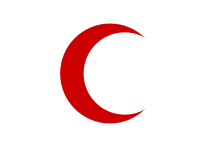Protocol III



Protocol III is a 2005 amendment protocol to the Geneva Conventions relating to the Adoption of an Additional Distinctive Emblem. Under the protocol, the protective sign of the Red Crystal may be displayed by medical and religious personnel at times of war, instead of the traditional Red Cross, or Red Crescent symbols. People displaying any of these protective emblems are performing a humanitarian service and must be protected by all parties to the conflict.
History
By the middle of the 19th century, modern warfare had become increasingly more violent. It was not uncommon for a combat medic on the field of battle to be fired upon and to die while collecting and caring for the wounded. There was a growing recognition of the need to distinguish medical personnel from enemy combatants, to make it easier for military commanders to avoid and protect them.[1] Allowing each country to develop its own emblem would have led to confusion. What was needed to save lives was a single neutral emblem that all countries recognized and used equally.
The 1864 Geneva Convention establishes that a distinctive emblem should be worn by medical personnel on the field of battle as an indication of their humanitarian mission and their neutral status.[2] At that time, the chosen symbol was a red cross on a white background. Muslim nations have objected to this symbol due to its resemblance to the Christian cross. As early as 1876, the Ottoman Empire introduced the Red Crescent as an alternative, less Christian emblem. Additional emblems have been proposed, including the red lion and sun of Persia,[3] the double emblem (both the red cross and red crescent together) by the Red Cross Society of Eritrea, and the red shield of David by Magen David Adom of Israel.
Over time the adoption of a single, universal emblem has been met with two recurrent difficulties:[4]
- They may be perceived as having religious, cultural or political connotations. This perception conflicts with neutral, humanitarian status of medical personnel in armed conflicts.
- These emblems are tied to membership in the National Societies. Members are required to use the red cross or red crescent emblem. Since Magen David Adom was unwilling to give up their red shield of David, they were not granted membership. Without membership, they were not eligible for certain protections under the Geneva Conventions.

In 2005, an international delegation finally achieved a comprehensive solution to these difficulties with the adoption of Protocol III. Magen David Adom is granted protections under the Geneva Conventions as long as they display the Red Crystal in the context of international conflict. As of January 2015, Protocol III has been ratified or acceded to by 72 countries and signed by a further 24.[5] The treaty came into force on 14 January 2007.
Governing rules
Article 2 of this brief protocol recognizes an additional distinctive emblem, the Red Crystal, that may be used in addition to, and for the same purposes as, the Red Cross and Red Crescent symbols. All three emblems are appointed the same legal status.
There are two distinct uses that are recognized for all three emblems:[6]
- Protective use. Medical and religious personnel may mark themselves, their vehicles, ships and buildings as a sign of their humanitarian mission and protected status under the Geneva Conventions, particularly the First Geneva Convention. The protections of the Geneva Convention do not depend on the wearing of the emblem. The emblems are merely a visible sign of the protected status of individuals. Members of the armed forces may use these markings at all times. Civilian institutions such as hospitals may use these markings temporarily, within the context of an armed conflict.
- Indicative use. Members of the movement may wear the emblems in both times of conflict and times of peace as an indication of their membership.
Misuse of these emblems is prohibited by international law. Misuse may diminish their protective value and undermine the effectiveness of humanitarian workers. Use of one of the emblems in order to protect combatants and military equipment with the intent of misleading an adversary, perfidy, is considered a war crime.[6]
See also
- List of parties to the Geneva Conventions: includes a list of states that signed and a list of states that have ratified Protocol III
References
| Wikisource has original text related to this article: |
- ↑ Bugnion, Francois (2000). Towards a comprehensive solution to the question of the emblem. International Committee of the Red Cross. Retrieved 2009-08-04.
- ↑ Pictet, Jean (1958). Geneva Conventions of 12 August 1949: Commentary. International Committee of the Red Cross. ISBN 2-88145-065-2. Retrieved 2009-08-04.
- ↑ The red lion and sun, while still a recognized protective symbol today, has fallen into disuse. Iran/Persia was the only country to use this symbol, and they have since switched to the Red Crescent after the Iranian Revolution.
- ↑ Pulles, Gerrit Jan (2005). "Crystallizing an emblem: on the adoption of the third additional protocol to the Geneva Conventions". Yearbook of International Humanitarian Law. International Committee of the Red Cross. 8: 296–319. ISBN 978-90-6704-244-4. Retrieved 2009-08-04.
- ↑ "States party to the main treaties". International Committee of the Red Cross.
- 1 2 Emblems of humanity. International Red Cross and Red Crescent Societies. 2007. Retrieved 2009-08-05.
External links
- Committee of the Red Cross: Full text of Protocol III with commentaries
- List of countries that have ratified Protocol III
- List of countries that have signed but not yet ratified Protocol III
- Press release from the International Committee of the Red Cross welcoming the signing of Protocol III